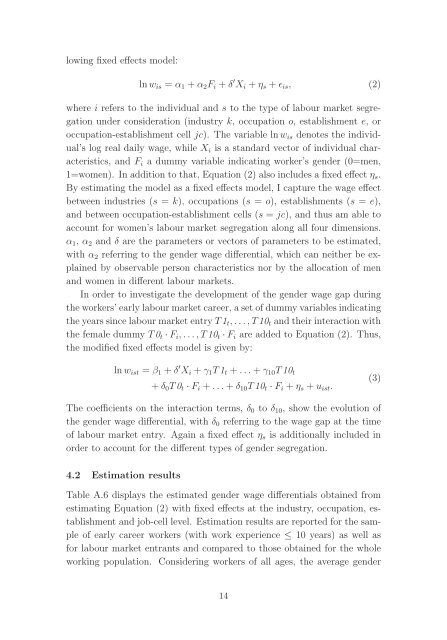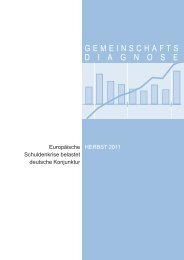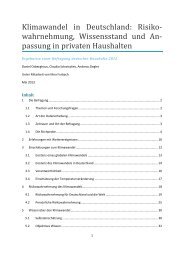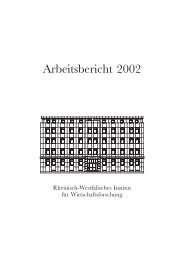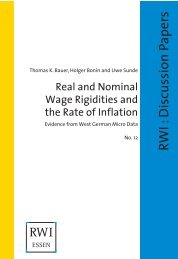Gender Segregation and Gender Wage Differences during the Early ...
Gender Segregation and Gender Wage Differences during the Early ...
Gender Segregation and Gender Wage Differences during the Early ...
You also want an ePaper? Increase the reach of your titles
YUMPU automatically turns print PDFs into web optimized ePapers that Google loves.
lowing fixed effects model:<br />
ln w is = α 1 + α 2 F i + δ ′ X i + η s + ɛ is , (2)<br />
where i refers to <strong>the</strong> individual <strong>and</strong> s to <strong>the</strong> type of labour market segregation<br />
under consideration (industry k, occupation o, establishment e, or<br />
occupation-establishment cell jc). The variable ln w is denotes <strong>the</strong> individual’s<br />
log real daily wage, while X i is a st<strong>and</strong>ard vector of individual characteristics,<br />
<strong>and</strong> F i a dummy variable indicating worker’s gender (0=men,<br />
1=women). In addition to that, Equation (2) also includes a fixed effect η s .<br />
By estimating <strong>the</strong> model as a fixed effects model, I capture <strong>the</strong> wage effect<br />
between industries (s = k), occupations (s = o), establishments (s = e),<br />
<strong>and</strong> between occupation-establishment cells (s = jc), <strong>and</strong> thus am able to<br />
account for women’s labour market segregation along all four dimensions.<br />
α 1 , α 2 <strong>and</strong> δ are <strong>the</strong> parameters or vectors of parameters to be estimated,<br />
with α 2 referring to <strong>the</strong> gender wage differential, which can nei<strong>the</strong>r be explained<br />
by observable person characteristics nor by <strong>the</strong> allocation of men<br />
<strong>and</strong> women in different labour markets.<br />
In order to investigate <strong>the</strong> development of <strong>the</strong> gender wage gap <strong>during</strong><br />
<strong>the</strong> workers’ early labour market career, a set of dummy variables indicating<br />
<strong>the</strong> years since labour market entry T 1 t ,...,T10 t <strong>and</strong> <strong>the</strong>ir interaction with<br />
<strong>the</strong> female dummy T 0 t · F i ,...,T10 t · F i are added to Equation (2). Thus,<br />
<strong>the</strong> modified fixed effects model is given by:<br />
ln w ist = β 1 + δ ′ X i + γ 1 T 1 t + ...+ γ 10 T 10 t<br />
+ δ 0 T 0 t · F i + ...+ δ 10 T 10 t · F i + η s + u ist .<br />
(3)<br />
The coefficients on <strong>the</strong> interaction terms, δ 0 to δ 10 , show <strong>the</strong> evolution of<br />
<strong>the</strong> gender wage differential, with δ 0 referring to <strong>the</strong> wage gap at <strong>the</strong> time<br />
of labour market entry. Again a fixed effect η s is additionally included in<br />
order to account for <strong>the</strong> different types of gender segregation.<br />
4.2 Estimation results<br />
Table A.6 displays <strong>the</strong> estimated gender wage differentials obtained from<br />
estimating Equation (2) with fixed effects at <strong>the</strong> industry, occupation, establishment<br />
<strong>and</strong> job-cell level. Estimation results are reported for <strong>the</strong> sample<br />
of early career workers (with work experience ≤ 10years)aswellas<br />
for labour market entrants <strong>and</strong> compared to those obtained for <strong>the</strong> whole<br />
working population. Considering workers of all ages, <strong>the</strong> average gender<br />
14


